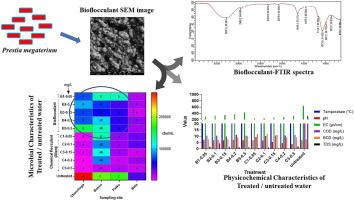Application of bioflocculants produced by Prestia megaterium for drinking water purification
Q1 Environmental Science
引用次数: 0
Abstract
Quality water is a scarce commodity in the developing countries. This paper aims to evaluate the application of bioflocculants produced by Priestia megaterium (accession number: ON184360) for drinking water purification. A total of twenty-four water samples from stream, ponds and wells were collected in sterile containers from four different Local Government Areas of Niger State, Nigeria. Each sample was treated with varying concentrations of bioflocculant and chemical flocculant (0.05, 0.1, 0.15, 0.2 and 0.5 mg L−1). The microbiological and physicochemical characteristics of the treated and untreated water were determined using standard methods. The results show that water samples from stream, ponds and wells treated with the bioflocculant significantly reduced the microbial load and the physicochemical properties of the water reduced to an acceptable limit, which has practical significance for the safety of drinking water in developing countries. The bioflocculant was effective in aggregating suspended particles and thus, proved its potential to be used as alternative flocculant in the drinking water treatment process.

将大型普氏菌生产的生物絮凝剂用于饮用水净化
在发展中国家,优质水是一种稀缺商品。本文旨在评估巨栉水母菌(登录号:ON184360)生产的生物絮凝剂在饮用水净化中的应用。本文从尼日利亚尼日尔州四个不同的地方政府区域,用无菌容器收集了溪流、池塘和水井中的 24 份水样。每个水样都用不同浓度的生物絮凝剂和化学絮凝剂(0.05、0.1、0.15、0.2 和 0.5 mg L-1)进行了处理。采用标准方法测定了经处理和未经处理的水的微生物和理化特性。结果表明,经过生物絮凝剂处理的溪流、池塘和水井水样的微生物负荷明显降低,水的理化特性也降低到可接受的限度,这对发展中国家的饮用水安全具有实际意义。生物絮凝剂能有效聚集悬浮颗粒,因此证明了其在饮用水处理过程中用作替代絮凝剂的潜力。
本文章由计算机程序翻译,如有差异,请以英文原文为准。
求助全文
约1分钟内获得全文
求助全文
来源期刊

Bioresource Technology Reports
Environmental Science-Environmental Engineering
CiteScore
7.20
自引率
0.00%
发文量
390
审稿时长
28 days
 求助内容:
求助内容: 应助结果提醒方式:
应助结果提醒方式:


